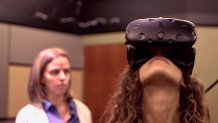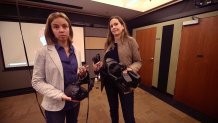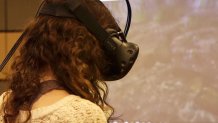On a recent day, a researcher was walking on the ocean floor, peering around at coral, urchins and picking up sea snails, turning them over in the palm of her glove to closely inspect them. The only catch: the explorer was actually in a dark, windowless room on the Stanford University campus pawing at the air. Joe Rosato Jr. reports.
On a recent day, a researcher was walking on the ocean floor, peering around at coral, urchins and picking up sea snails, turning them over in the palm of her glove to closely inspect them. The only catch: the explorer was actually in a dark, windowless room on the Stanford University campus pawing at the air.
The semi-departure from reality was a demonstration of a new virtual reality simulation under development by Stanford researchers aimed at teaching high school students about climate change. The team’s new virtual reality program teaches students about ocean acidification, the scientific concept where carbon dioxide from the atmosphere is increasing the acidity of the world’s oceans to the detriment of sea life.
"In school, environmental education is a difficult topic because it’s difficult to bring the kids to the ocean or even underwater," said Stanford researcher Geraldine Fauville.

But Fauville said with VR the team can now deliver an ocean experience to the classroom, especially since the virtual reality gear has become cheaper and lighter. Inside Stanford’s Virtual Human Interaction Lab, Fauville picked up a bulky headset tethered to multiple cords. She described it as an example of technology dating back four years. She then held out a much smaller, lighter headset to show how much more mobile the technology had become.
"It used to be extremely bulky and heavy and expensive to something that now consumers can have at their home or in schools," Fauville said.
Inside the simulation, a silky smooth voice talked over new-age music, prompting the participant to touch the tailpipe of a car which spewed out carbon molecules. The cartoon molecules floated across the sky before dropping into the ocean. Next, the viewer is transported to the ocean floor surrounded by a coral reef and schools of fish — the voice prompts to reach down and pick up a sea snail. A short time later, the same area turns brown and devoid of life to show the forecasted impact of ocean acidification.
"Using VR, you really feel the experience," said researcher Anna Muller. "All the emotional side of learning can really enhance learning."

The educational possibilities were demonstrated in a recent Stanford study which found that virtual reality "can be a powerful tool for improving environmental learning gains and attitudes." The emotional connection helped drive home the topics for students.
Local
"Using VR, students learned more,” Muller said. "They recalled more of the information they learned."
Fauville said the boundaries of learning could be vastly expanded through virtual reality — exposing students to a vast breadth of firsthand experiences they might never have otherwise. Still, Fauville said VR experiences were aimed at complementing education rather than replacing any traditional teaching methods.

"It’s just bringing something new, something different," Fauville said.
The advent of VR creates possibility beyond imagination. Seniors could experience the thrill of climbing Mount Everest. Art students could visit Renaissance Florence to watch Michelangelo paint.
"Do whatever you want to do," Muller said, "And experience whatever you want."



